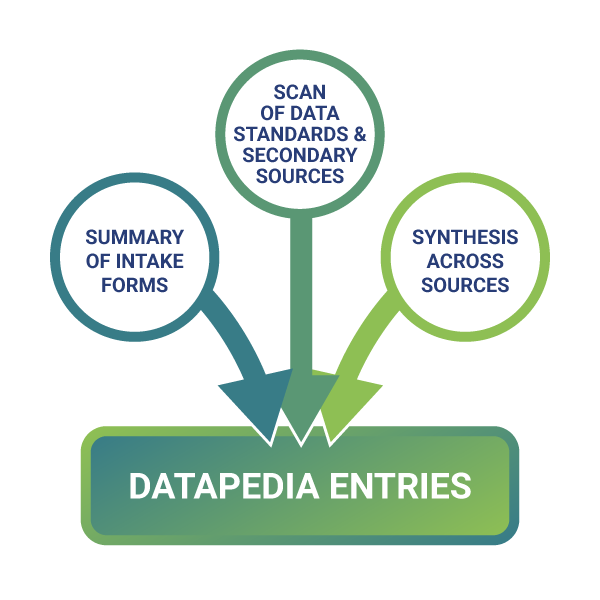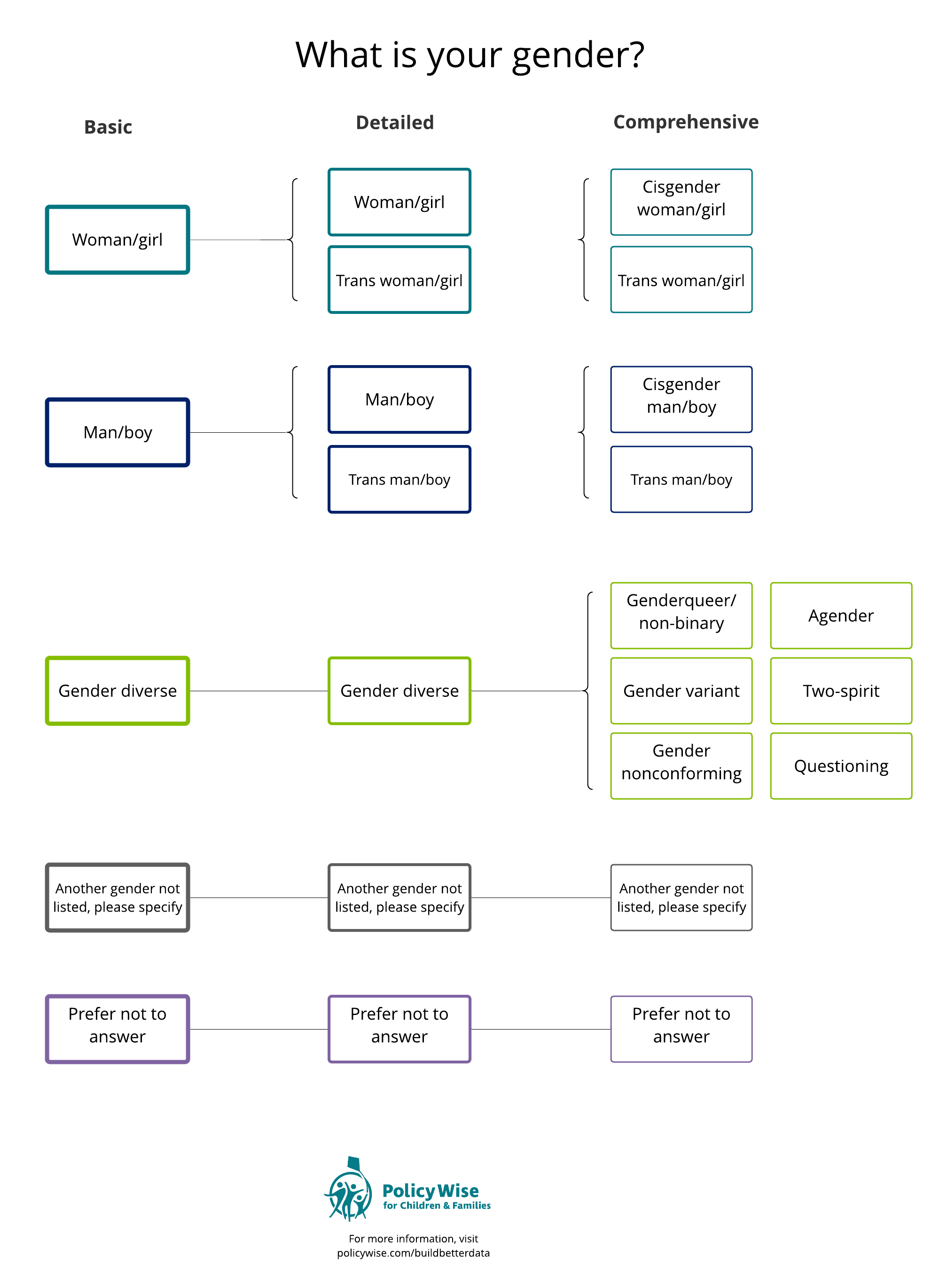Demographic Datapedia Entry:
Gender
Each Datapedia entry begins with definition(s) of the demographic variable followed by some considerations and limitations of the variable for understanding populations of people.
Next, a suggested question(s) and response options are shown. Note that this is given as guidance rather than a prescription of what’s best as that will depend on the information needs and context of your organization. Also included are ideas and examples of how to ask questions about the demographic variable in conversation.

Plan
It’s important to invest time in seeking out your “Why?” with data to ensure the data collected support your information needs. For more on this, see the Plan section of the Data Lifecycle.
Finally, a diagram is shown to illustrate basic, detailed, and comprehensive response options for the variable.
- The basic options are the minimum set of response options that are suggested for each variable.
- The detailed and comprehensive categories illustrate more detailed and nuanced response options that may be important to consider depending on your information needs and organization’s context.
- The diagram of response options show how each category can be collapsed into the basic set of answers. For example, the detailed and comprehensive response options can be collapsed or aggregated into the basic response options for analysis.
- Consider all response options when deciding on which category best suits your organization’s needs.
Importantly, the suggestions and details of the response options will need to be revisited and revised periodically to reflect shifts and changes that may emerge in various variables over time.1

BUILD
For ideas on how to collect and record quality data see the Build section of the Data Lifecycle.
2.1 Definition
A. Sex refers to one’s anatomical details, such as genitals, reproductive organs, chromosomes, and hormones, thought to define a person’s biological status as male or female and are generally assigned at birth.2
B. Gender refers to the roles, behaviours, activities, and attributes that a given society may construct or consider appropriate for the categories of “men” and “women”.3 Gender identity is an internal and deeply felt sense of being a man or woman, both or neither. A person’s gender identity may or may not align with the gender typically associated with their sex.2
2.2 Considerations and Limitations
Gender can be used to understand:
- Which genders are, or are not, being served e.g., using a GBA+ lens, or to support specific populations, meet expected numbers, or understand eligibility requirements.
- How programming may need to be adapted and responsive to reflect the gender diversity of participants.
- Aspects of operational planning or reporting such as that may be required by funders.
Gender cannot be used to understand:
- Sexuality4 and sexual orientation3, 5
- A person’s gender journey unless asked in a way that might capture that level of nuance6, 7
- Sex assigned at birth is a different question that may be appropriate to ask when it’s important to understand a person’s biology for the purpose of medical care, for example4, 5, 8, 9
Additional considerations:
-
- Whether to ask at all? Is it relevant to the supports that agencies are providing to clients?
- It is important to note that these terms and ideas around gender identity may not be accepted or understood by all cultures and in all contexts. As well, the range of conceptions for understanding gender diversity around the world is not fully captured here. It will be important to adapt this question and response options to best fit the communities and populations in which your organization works.
2.3 Suggested Collection Methods
The minimum suggested data collection method, or “basic” option reflects a synthesis of practices, considerations from nonprofit stakeholders, and recognized standards in capturing demographic data. The suggested method is modeled after what might be asked on an intake form during an initial meeting with a client. The process by which intake or registration occurs can vary widely depending on the context within which you are working. For example, the way questions are asked and data are recorded will vary for clients in crises, as compared to walk-in or drop-in sessions, or when registering for a program that requires people to meet certain eligibility requirements. In those cases, the suggested collection method can be used as a starting point but adapted to fit the needs of the context within which the data are being collected.
As a standard practice we suggest always including an option for people to write in an answer that may not fit within the options provided, along with an option not to answer. These are both important for creating inclusive demographic questions.1, 10, 11
2.3.1 Basic Question(s)
1. What is your gender?
- Woman/girl
- Man/boy
- Gender diverse
- Another gender not listed, please specify: ________
- Prefer not to answer
In conversation, the question may be phrased as:
- What are your preferred pronouns?
- Tell me about your gender journey.
- Are you comfortable sharing your gender identity?
2.3.2 Diagram of Response Options
The diagram shows an overview of the basic, detailed and comprehensive response options. The options are not necessarily exhaustive, but they are modeled after what organizations may want to provide depending on the needs and context of their work. The question can be found at the top of the diagram and the response choices are mapped into the basic, detailed, and comprehensive levels. Not all variables warrant all levels of response options.

COLLECT
For considerations on building trust and relationships through data collection see the Collect section of the Data Lifecycle.


LENSES
You may wish to approach your data collection work through the lens of a particular framework or set of guiding principles, which will shape how you think about your response options. For more details, see the Lenses section of the Data Lifecycle.
To create the diagram for variable responses, two main sets of sources were used.
- Organization intake and registration forms from nonprofit subsectors across Alberta.
- Best practices in data collection, academic literature of demographic data, and resources from data aggregators (e.g., Statistics Canada, National Institutes of Health).
Findings from these sources were synthesized and organized across three levels of response options: basic, detailed, and comprehensive. To learn more please see the full methods. Datapedia Project Approach and Acknowledgements.pdf
Footnotes
-
Frederick, J. K. (2020, November 18). Four strategies for crafting inclusive and effective demographic questions. Ithaka S+R Blog. https://sr.ithaka.org/blog/four-strategies-for-crafting-inclusive-and-effective-demographic-questions/
-
Manitoba Education and Training. (2017). Supporting transgender and gender diverse students in Manitoba schools. https://www.edu.gov.mb.ca/k12/docs/support/transgender/index.html
-
Status of Women Canada. (2018, September 26). Introduction to GBA+. cfc-swc.gc.ca/gba-acs/course-cours/eng/mod01/mod01_02_04.html
-
Treasury Board of Canada. (2019, April 8). Modernizing the Government of Canada’s sex and gender information practices: Summary report. www.canada.ca/en/treasury-board-secretariat/corporate/reports/summary-modernizing-info-sex-gender.html.
-
Ontario Human Rights Commission. (n.d.). Sexual Orientation.http://www.ohrc.on.ca/en/code_grounds/sexual_orientation
-
Alberta Health Services (2019, September). Sexual Orientation, Gender Identity & Gender Expression (SOGIE): An introduction for creating safer and more welcoming healthcare. https://www.albertahealthservices.ca/assets/info/pf/div/if-pf-div-sogie-safer-places-toolkit.pdf
-
Journeys in Film (2017). “Gender Revolution.” National Geographic, https://www.nationalgeographic.com/pdf/gender-revolution-guide.pdf
-
Iowa State University Center for LGBTQIA+ Student Success (n.d.) Asking about sexuality and gender. https://center.dso.iastate.edu/sites/default/files/Documents/Classroom/Asking%20about%20Gender%20and%20Sexuality.pdf
-
Statistics Canada (2020, July 20). Sex at birth and gender: Technical report on changes for the 2021 Census. https://www12.statcan.gc.ca/census-recensement/2021/ref/98-20-0002/982000022020002-eng.cfm
-
Fernandez, T., Godwin, A., Doyle, J., Verdin, D., Boone, H., Kirn, A., Benson, L., & Potvin, G., (2016). More Comprehensive and Inclusive Approaches to Demographic Data Collection. School of Engineering Education Graduate Student Series, 60. http://docs.lib.purdue.edu/enegs/60
-
Lesbian, Gay, Bisexual, & Transgender Equity Center. (n. d.). Good practices: Demographic data collection. University of Maryland. https://lgbt.umd.edu/good-practices-demographic-data-collection
Do you have additions to suggest to the Datapedia? Or, do you want to learn more about working with data?
We’d love to hear from you. Contact us at info@policywise.nickpetlock.com.


